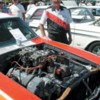The following excerpts are gleaned from two interviews of Don Nicholson appearing in the pages of Pantera International magazine, issue 71 (1992) and issue 93 (1997). Enjoy!
________________________________________
About himself:
Don Nicholson was given the name Dyno Don in the 1950s (before his drag racing career) because he worked at an engine shop that had a dynamometer.
He considered himself a drag racer and an engine builder. He was still racing nostalgia races and still building engines for customers out of his shop in Orange California in 1997, at the age of 70 (born in 1927).
He always did his own porting and valve work.
Ford never gave Dyno Don a paycheck or a bonus check for his racing efforts. Ford provided parts, they would help pay for the race cars, and they gave him his transportation cars.
Dyno Don considered Ronnie Sox his toughest competitor.
________________________________________
About his Pro Stock 351 Clevelands:
Dyno's pro stock Clevelands cost about $5000 to build.
A block would last an entire season, but the engine was torn down every 10 races to replace bearings, replace rings and to perform a valve job.
His tunnel ram was hand made.
His later Cleveland motors made 725 horsepower on the dyno, but he felt they picked up 50 more horsepower once they were installed and run.
He always filled the intake ports of his Cleveland heads, even for 10,000 rpm drag racing. He believed Ford should have made them 15% to 25% smaller.
He said the exhaust port plates improved exhaust port flow by 25%.
He complained the block's cylinder walls were too thin, and the lubrication system design was a giant step backwards.
He said the lifters acted like oil pumps, pumping the oil to the top end and away from the reciprocating assembly.
He said restrictor push rods didn't work with solid lifters because the oil would escape in the clearance between the lifter and the push rod. The oil also escaped in the clearance between the lifters and the lifter bores.
He resorted to using lifter bore bushings with 0.035" orifices, because it was the only measure that solved the problem.
He ran the stock crankshaft.
The alloy Cleveland blocks he used for match racing were acquired from Dan Gurney.
He liked aluminum blocks but felt they had to be cast thicker than iron blocks to have equal strength.
________________________________________
About building 351 Clevelands for high performance street use:
He ran titanium valves in his race engines of course, but he recommended them even for the street if you could afford them.
He preferred vacuum secondary carburetors because they were "smoother".
He recommended an ATI dampener in 1992, and spoke highly of BHJ dampeners in 1997.
He felt the cast iron ring of the stock dampener was capable of exploding when run hard.
He said aluminum dampeners were too light.
He said he liked TRW and Venolia pistons in 1992, but in 1997 he was building a motor with full round skirt Ross pistons.
He recommended 9.5:1 to 10.0:1 compression for the street, but said 10.5:1 was possible if you used "good gas".
He built his motors with 0.010" deck clearance.
He said it was important to keep the oil off the crankshaft, he recommended the deepest oil pan you could run, a wide oil pan if you couldn't run a deep one, a windage tray, and an oil scraper.
In 1997 he felt a McLeod aluminum flywheel and their 10" dual disk clutch was a bullet-proof combination.
_________________________________________
-G
Attachments
Original Post


